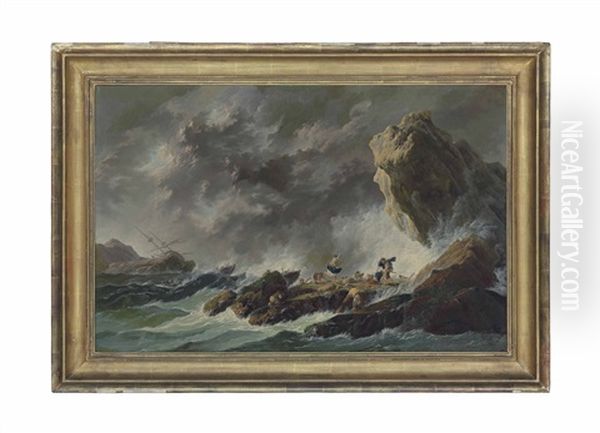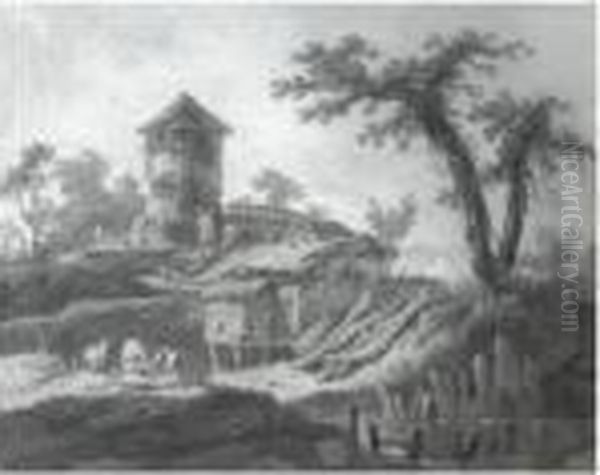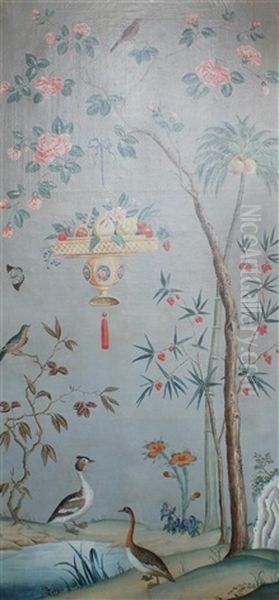Jean-Baptiste Pillement stands as a significant figure in eighteenth-century European art, a French painter and designer whose prolific career spanned diverse geographical locations and artistic mediums. Born in Lyon on May 24, 1728, and passing away in the same city on April 26, 1808, Pillement's life encompassed the flourishing and eventual decline of the Rococo style. He became renowned for his delicate landscapes, captivating seascapes, and, perhaps most notably, his imaginative and highly influential Chinoiserie designs, which left an indelible mark on the decorative arts across the continent. His extensive travels and adaptability allowed him to absorb and contribute to various artistic currents, making him a truly cosmopolitan artist of his time.
Early Life and Artistic Formation
Jean-Baptiste Pillement's journey into the world of art began in Lyon, a city known for its thriving silk industry. He was born into an environment conducive to artistic pursuits; his father, Paul Pillement, was not only involved in the textile trade but was also recognized as a painter. This familial background undoubtedly provided early exposure and encouragement. Pillement received his initial artistic training in his native Lyon before venturing to Paris around 1743, seeking broader opportunities and more advanced instruction.
In the French capital, the young artist found employment as a draftsman at the prestigious Gobelins tapestry manufactory. This experience likely honed his skills in design and composition. Crucially, he furthered his artistic education under the guidance of Daniel Sarrabat (also spelled Sarrat), a painter whose instruction would have grounded Pillement in the prevailing tastes of the era. Paris, at this time, was the epicenter of the Rococo movement, with artists like Antoine Watteau having already established its lighthearted, elegant, and often pastoral themes. Pillement absorbed these influences, preparing him for a career that would both embrace and expand upon the Rococo aesthetic.
A Pan-European Career: Travels and Patronage

Pillement's career was characterized by remarkable mobility. Unlike many artists who remained centered in one primary location, he embarked on extensive travels, working for patrons across Europe. Around 1745, his journeys took him to the Iberian Peninsula. He spent time in Madrid, Spain, before moving to Lisbon, Portugal, around 1750. His talents attracted royal attention, and he served as a court painter to the Portuguese monarchs, King Pedro III and Queen Maria I. This period in Portugal was significant, allowing him to develop his landscape and decorative skills further.
Following his time in Portugal, Pillement relocated to England around 1754-1755, spending several productive years primarily in London. His charming landscapes and decorative designs found favour with the British public and collectors. During his London stay, he collaborated with the French engraver and dealer Charles Leviez (or Levizzani), who helped disseminate Pillement's work through prints, significantly boosting his reputation. His art was admired by prominent figures, including the celebrated actor David Garrick. Pillement's success in London demonstrated his ability to adapt his style to different national tastes while retaining his distinctive Rococo elegance.
His travels did not end there. Over the subsequent decades, Pillement worked in various major European cities and courts. He spent time in Italy, absorbing the classical landscapes and artistic heritage. He also worked in Vienna for the Imperial court, and in Warsaw for King Stanisław August Poniatowski of Poland, further cementing his international renown. These diverse experiences enriched his artistic vocabulary, exposing him to different landscapes, cultures, and patronage systems, all of which subtly informed his evolving style.
Artistic Style: Rococo Elegance and Landscape
Pillement's primary artistic allegiance was to the Rococo style, yet he carved a unique niche within it. While contemporaries like François Boucher and Jean-Honoré Fragonard often focused on mythological scenes or intimate genre paintings populated with sensuous figures, Pillement excelled in landscape and decorative compositions. His landscapes are characterized by their delicacy, idealized pastoral beauty, and often dramatic use of light and atmosphere. He depicted tranquil countryside scenes with shepherds and ruins, evoking a sense of gentle nostalgia, but could also capture the dynamic energy of nature in works like seascapes featuring shipwrecks and storms.

His technique was versatile, encompassing oil painting, watercolor, and particularly pastel. He is considered one of the most accomplished pastel artists of the Rococo era. This medium perfectly suited his penchant for subtle tonal gradations, vibrant yet refined color palettes, and the rendering of light effects, from the soft glow of dawn to the dramatic contrasts of a storm. His work often shows an affinity with earlier landscape traditions, perhaps echoing the idealized compositions of Claude Lorrain or the pastoral scenes of Dutch Italianate painters like Nicolaes Berchem, yet always filtered through his distinctively light and graceful Rococo sensibility. His seascapes invite comparison with the work of specialists like Claude-Joseph Vernet, though Pillement's approach remained generally more decorative.
Artistic Style: The Allure of Chinoiserie
Beyond his landscapes, Jean-Baptiste Pillement was a pivotal figure in the popularization of Chinoiserie throughout Europe. Chinoiserie, a style inspired by European interpretations of Chinese and East Asian art and design, was a hallmark of Rococo interiors and decorative arts. Pillement did not merely follow this trend; he became one of its most imaginative and prolific proponents. His Chinoiserie designs were not attempts at authentic representation but rather fantastical concoctions blending exotic motifs—pagodas, mandarins, parasols, dragons, whimsical flora and fauna—with Rococo scrolls, asymmetry, and lightness.
He created numerous suites of engravings dedicated to Chinoiserie themes, such as the influential "A New Book of Chinese Ornaments" (published in London, 1755) and various collections of floral and ornamental designs. These prints were instrumental in spreading his unique vision. They provided source material for artisans across Europe, demonstrating his flair for intricate, playful, and elegant patterns suitable for a wide range of applications. His Chinoiserie was less about depicting China and more about capturing a spirit of exoticism, fantasy, and refined amusement that perfectly complemented Rococo interiors.
Master of Decoration: Prints and Widespread Influence
Pillement's significance extends far beyond his easel paintings. His true impact lies arguably in his role as a designer whose ideas permeated the decorative arts of the era. The numerous engravings made after his drawings served as pattern books for craftsmen in various fields. His Chinoiserie motifs, floral compositions, and ornamental arabesques were adapted for use on porcelain, faience, textiles (particularly silks, fitting given his Lyon origins), wallpaper, furniture marquetry, and painted wall panels.

Factories across Europe utilized his designs. For instance, his patterns influenced production at major ceramic centers like Sèvres in France and even Meissen in Germany. His work provided a readily accessible vocabulary of Rococo and Chinoiserie ornament that could be applied to objects large and small, contributing significantly to the cohesive aesthetic of eighteenth-century interiors. Through the medium of print, Pillement's artistic inventions reached a far wider audience than his paintings alone ever could, making him a key transmitter of French taste across the continent. His wife, Anne Allen, an artist herself, actively participated in this dissemination, engraving many of his designs, particularly floral studies and the collaborative "Chinese Arabesques."
Key Works and Themes
While Pillement was incredibly prolific, several works and recurring themes exemplify his artistic contributions:
Landscapes with Pastoral Figures: Works like Landscape with Shepherds beside a Stream or Landscape with Travelers and a Ruin showcase his idealized vision of nature, often featuring gentle hills, picturesque ruins, delicate foliage, and small figures harmoniously integrated into the scene. These paintings emphasize tranquility and Rococo grace.
Seascapes and Shipwrecks: In contrast to the pastoral calm, paintings such as A Shipwreck in a Storm demonstrate his ability to depict the more dramatic aspects of nature. These works often feature turbulent seas, dynamic cloud formations, and dramatic lighting, capturing the sublime power of the ocean within a Rococo framework.
Chinoiserie Compositions: Paintings like Market Scene or watercolors such as Chinoiserie Fantasy embody his imaginative engagement with exotic themes. These works are filled with fantastical architecture, figures in exotic dress, and whimsical details, creating vibrant, dreamlike visions of the East.
Decorative Designs and Prints: Series like A New Book of Chinese Ornaments and Chinese Arabesques (created with Anne Allen) are crucial to understanding his influence. These engraved designs, often featuring intricate floral patterns, exotic figures, and playful asymmetry, were his primary means of impacting the broader field of decorative arts. Ornamental Design prints encapsulate his skill in creating elegant, adaptable patterns.
These examples highlight the range of Pillement's output, from serene landscapes to dynamic seascapes and highly influential decorative fantasies.
Collaborations and Artistic Context
Pillement's career unfolded within a rich artistic milieu. His collaboration with his wife, Anne Allen, was significant, particularly in the production of engravings that popularized his designs. Their joint work on series like "Chinese Arabesques" underscores the familial aspect of artistic production in this era. His association with Charles Leviez in London was also crucial for establishing his reputation in England through the sale and publication of prints.
He worked during the height of the Rococo period, alongside major figures like François Boucher and Jean-Honoré Fragonard in France. While sharing the Rococo sensibility, Pillement's focus on landscape and decorative design distinguished him from their often more figural or narrative works. His travels brought him into contact with artistic circles across Europe. In England, he was a contemporary of landscape and portrait painters like Thomas Gainsborough. His work resonated with the prevailing taste for the picturesque and the exotic. His landscape style can be seen as continuing traditions established by earlier masters like Claude Lorrain and Nicolaes Berchem, while his decorative inventiveness places him alongside other key Rococo designers. He was also contemporary with sculptors like Jean-Antoine Houdon and Étienne Maurice Falconet, who contributed to the era's artistic richness.
Later Years and Legacy
After decades of travel and international success, Pillement's later career saw him return periodically to Portugal (notably between 1782 and 1786) before finally settling back in his native Lyon around 1787. In his later years, he focused more on teaching, passing on his skills to a new generation. He continued to work on decorative projects. However, by this time, artistic tastes in France and much of Europe were shifting dramatically. The lightness and fantasy of the Rococo were giving way to the more austere, morally serious, and classically inspired style of Neoclassicism, championed by artists like Jacques-Louis David.
Despite the changing fashions, Pillement continued to work, though perhaps with less prominence than in his heyday. He remained in Lyon until his death on April 26, 1808. While the Rococo style itself had fallen out of favor by the time of his death, Pillement's legacy endured, particularly through his vast output of decorative designs. His work remains a testament to the elegance, charm, and imaginative power of the Rococo era. He is remembered not only as a skilled painter of landscapes and seascapes but, more importantly, as a master designer whose Chinoiserie and ornamental fantasies profoundly shaped the decorative arts of the eighteenth century across Europe. His ability to synthesize various influences and disseminate his style through prints secured his place as a uniquely influential figure in the history of European art and design.
Conclusion
Jean-Baptiste Pillement was far more than just a painter; he was a quintessential artist of the Rococo age – versatile, widely traveled, and immensely influential. His journey from Lyon to the courts and artistic centers of Europe reflects a career built on talent, adaptability, and an astute understanding of contemporary taste. While his delicate landscapes and dramatic seascapes showcase his skill with brush and pastel, his enduring legacy lies significantly in his role as a master designer. Through his imaginative Chinoiserie and elegant ornamental prints, Pillement's art permeated the fabric of eighteenth-century life, adorning everything from palace walls to porcelain teacups. He remains a key figure for understanding the international diffusion of the Rococo style and the enduring European fascination with the exotic East.